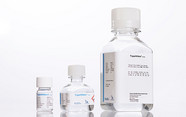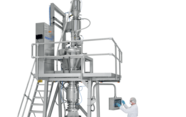Antibiotics: Going With the Flow
How fluid flow through the body can affect the ways in which antibiotics work.

Can studying the flow help to improve antibiotic drug development? Joe Sanfilippo of the University of Illinois Urbana-Champaign and co-authors have been studying how flow affects the penetration of different antimicrobials into bacterial populations.
Sanfilippo said: “Anytime you take an antibiotic orally or by IV, it’s not immediately in the place it is supposed to be. It will get there by flowing in the bloodstream. Other fluids move throughout the body as well: in the lungs, the urinary tract, the digestive tract. Yet biologists don’t really study the impact of fluid flow when they study pathogens. By using this microfluidic technology, often used in engineering, in a biology setting, we found that fluid flow is very important for antibiotic activity. We have an opportunity to make our drug screening and testing better by considering the effects of fluid flow.”
Traditional research on antimicrobial action often overlooks the role of environmental mechanics, such as fluid flow. In the human body, antimicrobials must navigate complex environments, often under shear forces generated by blood, mucus, or other physiological fluids. A study from Sanfilippo and co-authors sought to investigate how flow alters antimicrobial gradients and bacterial susceptibility.
Larger molecules, such as gentamicin, were found to diffuse more slowly than smaller ones, such as H2O2. While increasing concentration improves antimicrobial penetration, increasing flow can achieve similar results without raising drug levels, leading to implications for clinical antibiotic use.
The researchers used a combination of microfluidic experiments and biophysical simulations to study how flow affects antimicrobial gradients and bacterial survival, with key experimental techniques including:
- custom-fabricated microfluidic devices to track antimicrobial diffusion and bacterial response
- fluorescent biosensors to measure antimicrobial concentrations in real time
- controlled flow rates to assess antimicrobial penetration under different conditions.
In static conditions, P. aeruginosa neutralizes antimicrobials, creating local protective zones where bacteria shield each other. As flow increases, antimicrobial delivery outpaces bacterial neutralization, extending penetration deeper into the population.
Through the introduction of mechanomicrobiology as a factor in antimicrobial resistance research, the study highlights how increasing flow can enhance the effectiveness of existing antibiotics, potentially reducing the need for higher doses that drive resistance.
By considering fluid dynamics, drug developers can look for potential applications in:
- improved drug delivery strategies such as the optimization of intravenous and inhaled therapies by considering fluid dynamics
- better antibiotic susceptibility testing and modified protocols to reflect real-world conditions
- new therapeutic approaches that take into account mechanical forces to disrupt bacterial defense mechanisms.
By accelerating drug delivery and overcoming bacterial resistance mechanisms, shear forces could be leveraged to improve treatment outcomes and combat antimicrobial resistance. The research could open the door for future investigations into how physical forces can be integrated into antimicrobial development and clinical practice, and develop more effective medicines and modalities to help take on the ever-present threat of antimicrobial resistance.
Following a Bachelor’s degree in English Literature and a Master’s in Creative Writing, I entered the world of publishing as a proofreader, working my way up to editor. The career so far has taken me to some amazing places, and I’m excited to see where I can go with Texere and The Medicine Maker.



















